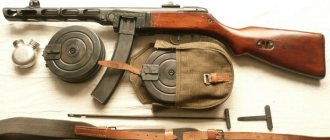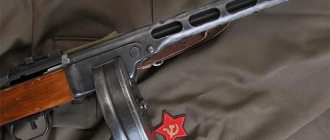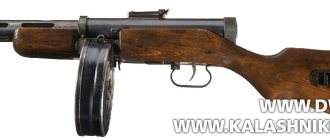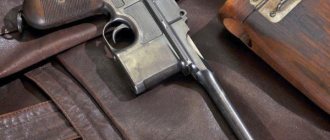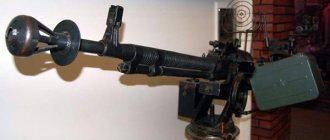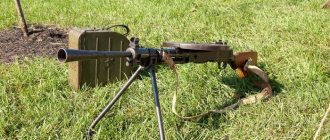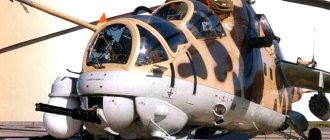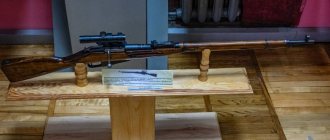Reasons and process of creation
Drawing conclusions from the Soviet-Finnish War (1939 - 1940), the leadership of the USSR gave the order to develop a modern and technologically advanced submachine gun (PP). The new weapon was supposed to match the combat characteristics of the PPD-34/40 (Degtyarev PP), but be easier to manufacture.
By the fall of 1940, G. Shpagin and B. Shpitalny presented their projects to the commission of the People's Commissariat of Armaments.
At the end of November, the Shpagin design bureau produced 25 products, the Shpitalny design bureau produced 15 units intended for testing tactical and technical characteristics. Along with the presented samples, PPD-40 also took part in the tests.
The tests included testing for structural strength, accuracy of fire, combat rate of fire and weight-dimensional characteristics.
By the end of the tests, the commission concluded that the Shpagin submachine gun was more suitable for the needs of the Soviet armed forces. Since it has better reliability, its parts are less susceptible to wear, with a mass equal to the PPD, it is easier to manufacture, and is not much inferior to the Shpitalny PP in accuracy and magazine capacity (but it weighs 1.5 kg more).
As a result, in December 1940, a decree was signed on the adoption of Shpagin's software and the start of its production. The project presented by Shpitalny was sent for revision, citing the low reliability of the automation.
"Saiga-9"
The most famous and best-selling line of civilian weapons from Izhmash is, of course, the Saiga family of Kalashnikov-like carbines. “Kalashmats,” as they are affectionately called by the people, are presented on the civilian weapons market in a wide variety of smooth-bore and rifled versions - for hunting, sports and recreational shooting.
It is not surprising that when a few years ago the factory workers came up with the idea of making something civilian for a 9-mm pistol cartridge, the result was another “Kalashmat”, known as “Saiga-9”.
However, this time appearances were deceiving. Under the familiar outlines of a Kalash with a 367 mm long barrel lies the filling of the PP-19-01 Vityaz submachine gun. It was developed in Izhevsk in 2004 as a simplified version of the PP-19 “Bison” - the brainchild of the sons of famous designers Mikhail Kalashnikov and Evgeny Dragunov. The fact is that it is impossible to take and make a version of the Kalashnikov with a 9-mm caliber barrel and the corresponding magazine: the low-power 9x19 pistol cartridge is not suitable for a gas-operated machine gun, designed for ammunition with a completely different energy. As a result, the Saiga-9 only had the appearance of the Kalashnikov, but the mechanics were completely changed. The gas-operated reloading system was replaced by a blowback system from the Vityaz, adopted as the standard in the submachine gun segment. The characteristic casing of the gas tube, by which both an AK and any Saiga are immediately recognizable, was left as a prop in order to preserve the look familiar to many.
© wikimedia.com
KSO-9 "Krechet".
Description and performance characteristics
The operating principle of the automatic Shpagin machine gun is based on a free-moving bolt and the use of recoil energy. The mainspring is cocked and activated when the trigger is pressed. Afterwards it straightens, which leads to the bolt moving forward and puncturing the cartridge case.
After the shot, the bolt, due to the powder gases, moves back to its original position.
The spent cartridge case flies out and a new charge takes its place. The ammunition is fed from a drum and sector type magazine. Hook type fuse. Around the barrel is a metal casing with oval holes and a bevel at the end. This innovation by Shpagin protected the fighter’s hands from burns and at the same time worked as a recoil compensator.
Looking at the large-scale cut-away plan of the PPSh submachine gun of the 1941 model, you can notice that the parts depicted on it are extremely simple and reliable.
Such design features allow it to be assembled on non-core production lines. For example, in tractor factories. The entire structure is made of steel, the butt is wooden (mostly birch). Parts are made by cold stamping and electric welding.
PP Shpagina has the following technical parameters:
- Weight: Without magazine – 3.6 kg. With a drum-type magazine - 5.3. With sector – 4.15 kg;
- Length: total product – 84.3 centimeters, barrel – 26.9 cm;
- Ammunition used: 7.62x25 mm TT, pistol;
- Caliber: 7.62 mm;
- Firing speed: up to 1000 rpm;
- Initial bullet speed: 500 m/s;
- Firing mode: automatic, semi-automatic;
- Firing distance max/effective: 500 m / 200 – 300 meters;
- Power type: drum (71 cartridges) and sector (35 cartridges);
- Sights: static, open type at 100 m and equipped with a folding line - 200 m.
KSO-9 "Krechet"
Zlatoust Machine-Building Plant produces its own version of a submachine gun with the appearance of an assault rifle - KSO-9 “Krechet”. The semi-automatic carbine is based on the well-known PP-91 “Kedr” submachine gun by Evgeny Dragunov. In the guise of the Krechet, a trained eye will easily spot the familiar Kedr box with its characteristic strictly vertical magazine shaft. However, what distinguishes the Krechet from the compact submachine gun is its long barrel (360 mm), protected by a false fore-end with three integrated Weaver straps for hanging the handle, tactical flashlights and other tuning elements, as well as a tactical polymer stock with adjustable length and an intimidating, but quite useless muzzle brake-compensator.
According to the tradition accepted in Russia, the Krechet carbine is factory-made, although in reality it, like the Saiga-9, is intended only for sports and “hobby” target shooting at distances of about 50 meters.
In this capacity, “Krechet” is not bad for lovers of “tactical-cosmic” looking weapons. However, if hunting from an oversized submachine gun is so important to its owner, from the Krechet he can quite successfully shoot, say, a beaver...
© wikimedia.com
PPSh.
Advantages and disadvantages
Like most types of weapons designed before and during the Great Patriotic War, the PPSh was extremely simple and effective. This weapon was appreciated not only by Soviet soldiers, but also by soldiers of the Allied countries and even in the Wehrmacht.
The Shpagin machine gun also had shortcomings, some of which were corrected already in 1942.
Briefly about the advantages
- Ease of production. The PPSh was assembled from spare parts made by cold stamping and spot welding. This did not require manual modification and saved time on machine hours. PPSh were even assembled by Belarusian partisans from parts made at home, without drawings;
- High rate of fire. The drum magazine was fired in ten seconds, which made it possible to create a high density of fire at a short distance, filling the enemy with hot lead. SMGs were mainly used in conditions of dagger combat: clearing trenches during tank landings, urban battles. In particular, for battles in urban areas, the PPSh-41 with a sector magazine was used, which increased the mobility of the serviceman.
Briefly about the disadvantages
- High weight and inconvenience. The simple design of the PPSh revealed a serious drawback - heavy weight. It weighed 5.3 kg with a drum magazine loaded. In addition, the fighter carried with him more ammunition and 2 spare clips. The problem was partly solved by introducing a smaller sector magazine. It had less mass and took up much less space;
- The drums of one PPSh did not fit the other. Cold stamping, although it produced a fast pace of product production, made each sample unique. In particular, this concerned cartridge power elements. If it was lost, it was extremely difficult to find a replacement, and given that only 3 magazines were produced with each barrel, this created a real problem;
- The high rate of fire led to quickly running out of ammunition. In fact, the fighter carried with him 3 equipped drums. A total of 223 rounds. With a rate of fire of 1000 rounds per minute, the ammunition was consumed very quickly. After which the soldier had to begin equipping the clip with new ammunition. In the conditions of current fire contact, this is very difficult. The problem of equipping the magazine with cartridges also aggravated the situation. It was difficult and if even one cartridge was misaligned, I had to start all over again.
- Some design flaws: a crossbow when dropped, the magazine falling out of the mount;
- Ease of manufacture did not mean high wear resistance of parts; this led to a loss of reliability of the machine. In battle conditions, this was an important factor. The battles took place in urban conditions, on rough terrain, in trenches. All these places were not clean. This claim mainly applies to non-core factories.
Automatic and submachine gun
Let's start from afar. What, exactly, is the difference between a machine gun and a pistol? Automatic, by the way, is an exclusively domestic term. The world has adopted another name for this type of weapon: assault rifle. The weapon is designed for the so-called intermediate cartridge - 5.45x39 or 5.56x45. It is moderately powerful, optimal for burst fire. The type of automatic reloading is not particularly important, but the gas principle is more often used. The long barrel allows for targeted shooting over a considerable distance.
A submachine gun is also an automatic weapon that supports continuous fire, but is much more compact, with a shorter barrel. Intended for use at short distances, in confined spaces, for security and defensive actions, not offensive. For this reason, submachine guns use pistol cartridges with low power and bullet speed and the corresponding type of mechanics - usually the so-called blowback action.
Russian legislation does not allow citizens to own short-barreled firearms - pistols, revolvers, and also, of course, submachine guns due to their small dimensions, which do not fit into the requirement for the minimum permissible length of weapons. We only use “long-barreled guns” - shotguns, rifles and carbines - mainly with hunting functionality.
Popular sports and recreational shooting from such weapons has its own nuances and limitations: strong noise and recoil, high cost of ammunition, the danger that a rifled cartridge bullet retains at a great distance, and restrictions in the rules of many shooting ranges. Therefore, for those who like to shoot a lot, often and inexpensively, but are not satisfied with a small caliber (.22), a separate class of weapons has appeared - self-loading carbines chambered for a pistol cartridge and with submachine gun mechanics. They are perfect for sports and amateur dynamic shooting. With such a weapon you can visit any shooting range certified for a pistol and with short galleries. The shot is not as powerful as that of a 12-gauge, and the bullet loses its lethal energy much earlier, unlike, say, 7.63x39.
Here are a few typical and popular models of weapons that represent this still specific and not very broad segment.
© wikimedia.com "Saiga-9".
Why not PPD
The Soviet command never took the PP seriously. It was considered a weapon for the police and gendarmes. However, some Soviet designers proactively developed projects for their submachine guns.
One of these people was Degtyarev. Its PPD-34 was mass-produced and mainly served in the ranks of the NKVD border service.
After the Winter War with the Finns, who massively used Suomi PP. The leadership of the Red Army urgently instructed Degtyarev to finalize the PPD-34.
And in the winter of 1940, he presented a new modification of his project - PPD-40.
By the beginning of the Second World War, about 90 thousand copies of it were produced.
At the same time, Stalin ordered the involvement of the best gunsmiths in the creation of a new PP, which would be easier to produce, but retain the combat qualities of the PPD-40. The Degtyarev submachine gun itself is complex. To create it, you need high-precision equipment and manual grinding.
History of PPSh during World War II
The Shpagin submachine gun, also known as PPSh-41, became the most common automatic personal weapon of soldiers of the Red Army (Workers' and Peasants' Red Army).
It was distributed in various branches of the military: infantry, guards units, airborne groups. It was also actively used by partisans operating in German-occupied territory.
Even German soldiers willingly used it instead of the MP-38/40.
The ROA (Russian Liberation Army) of Vlasov also had their own PPSh.
Ease of use made it possible to reduce the training period for recruits. And this is important in conditions of military operations.
This PP has proven itself in tank landings. After breaking through the defense line with tanks, soldiers with PPSh in their hands burst into the enemy’s trenches and used the so-called “trench broom” tactics.
Taking advantage of the high rate of fire, they suppressed enemy soldiers with fire, which left them no chance to survive.
He performed well in urban battles. The Battle of Stalingrad can be called the baptism of fire for this weapon. The fierce battle for the city took place in densely built conditions and numerous confined spaces.
In this kind of battle, the main thing is the rate of fire and the ability to suppress the enemy with continuous fire. The same thing happened in Kharkov and in the spring of 1945 in Berlin.
Options and modifications
During its long existence, the PPSh was modified more than once, and a huge number of types of this machine gun spread throughout the world.
It is impossible to list all of them due to the wide distribution and uncontrolled movement of this software.
Officially, it was supplied to countries such as China, Vietnam, Poland and Cuba.
Factory Soviet models:
- PPSh-41 arr. 1941 – first sample. It was equipped only with a drum magazine and a sight designed for shooting at a distance of up to 500 m.
- PPSh-41 arr. 1942 – differs from the ’41 model by a chrome-plated bore (Increases wear resistance), more reliable fastening of the clip and the elimination of an involuntary shot when falling. It was equipped with an aiming device for shooting at 100 - 200 meters. A sector magazine made of steel 0.5 mm thick (Later – 1 mm);
- PPSh-2. In 1943, a competition was announced for the development of a new submachine gun, which was supposed to be a replacement for the PPSh. The main requirements were maintaining combat qualities, reducing weight and dimensions. The product presented by Shpagin, although it was further simplified in production, did not meet the requirements. The choice fell on the project of the gunsmith Sudakov.
Handicraft and semi-handicraft models:
- “Product No. 86” - were manufactured in Kandalaksha on the territory of plant number 310. Before receiving the drawings, 100 products were produced. All of them were made by hand and their parts were not interchangeable. Like production models, the machine gun was equipped with a drum magazine;
- Many samples of the Shpagin submachine gun were made in the workshops of various partisan detachments operating on the territory of Belarus;
- Jelen - Croatian semi-handicraft modification, which was actively used in the wars on the Balkan Peninsula.
In the ranks of the Third Reich:
- MP.41(r) – captured PPSh-41 converted to the 9x19 “Parabellum” pistol cartridge, common among the Germans. The weapon had a replacement barrel and a receiver for clips from the MP-38/40. In total, about 10,000 pieces were converted.
During the Second World War and after its end, PPSh was produced in many countries. Among them were China, Yugoslavia, Iran, Croatia, Vietnam, Hungary, North Korea, etc.
Basically it was an ordinary Shpagin submachine gun. Only in rare cases were minor modifications made to suit the realities of local industrial potential.
Conversion options
- PPS-50 – Manufactured by Pletta. Uses small caliber ammunition - .22 LR;
- SR-41 Semi-Auto Rifle – Produced by the American arms company “Inter-Ordnance of America”. There is a modification chambered for 7.62x25 and 9x19 mm. Has an increased barrel length. American weapons connoisseurs have always spoken highly of the PPSh-41.
- SKL-41 – developed for the 9x19 cartridge. Start of production 2003
- PPSH 41 SemiAuto is a self-loading modification using a 7.62x25 cartridge. The key feature is an extended barrel (up to 16 inches), a casing without specific and recognizable oval holes. Shooting occurs with the shutter closed. Manufactured by the American company “Allied Armament”;
- VPO-135 – Cartridge 7.62x25. System: self-loading carbine. Date of development: 2013. Produced by the Molot plant;
- PPSh-O - Cartridge 7.62x25. System: self-loading carbine. Date of development: 2013. Produced by the Kovrov plant named after Degtyarev;
- MR-562K "PPSh" - a pneumatic version developed at the Izhevsk plant. Shoots 4.5 mm metal balls. Can fire in bursts.
MAKSIMOV.SU
Yuri Maksimov, Konstantin Lysov
photo by the authors
For several years now, the PPSh-Luger hunting carbine has been present on our market of civilian rifled weapons.
Some lovers of historical weapons have purchased or are seriously thinking about purchasing this model.
In this article
we will try to answer a number of questions regarding the design features and practice of using 9 mm PPSh.
PPSh
chambered for 7.62x25 mm and 9x19 mm
Here
you will also find answers to the most frequently asked questions about the main problems when using this weapon. For clarity, the article uses illustrations of a hunting PPSh chambered for the classic 7.62x25 mm cartridge.
Partial disassembly
of PPSh-41
Design Features
PPSh-O
Donor
in the manufacture of PPSh chambered for the 9x19 mm cartridge, 7.62 mm PPSh-O is used. Manufacturer: ZID. These are mainly copies of 43-45 years of production.
Manufacturer
This modification is now called MA Trade LLC. Some people confuse this. But these are different manufacturers, although they are both located in Vyatskie Polyany.
To the civilian market
Most of them were used PPShs that underwent arsenal repairs in the late 1950s-1960s, during the re-equipment of the army with AKs. It is from these that the “PPSh-O” is made, and then the “PPSh-Luger” version.
Basics
The difference between these versions of PPSh is the caliber and the cartridge used.
The PPSh-Luger uses a 9x19 barrel manufactured by MA Trade. The barrel is forged, not chrome-plated, with six right-hand rifling; at the beginning of production it was longer than the standard PPSh barrel by about 2 centimeters. Shooting from a hunting PPSh
Pin
and there are no other marks in the barrel. The marks on the left side of the receiver, applied to the ZID, have been erased. Instead, new ones are applied on the inner surface of the receiver. In later series (after 2016), the barrel was installed at a standard length for PPSh, so there are no visual differences from the PPSh-O, except for brands.
IN
everything else is similar to the “PPSh-O”: in the drum magazine there is a pin limiting its capacity to ten rounds, a fire mode selector is welded in, a screw connecting the bolt box to the trigger block is welded in, a mark is on the shutter mirror.
In 2017-2018
. on civilian PPSh they began to additionally weld the axis connecting the receiver and bolt and securing the barrel. All spare parts (including magazines) for the PPSh-Luger fit PPSh without alterations or changes.
Shooting
from a hunting PPSh
PPSh stores,
problems and their “treatment”
Now
There is a widespread opinion, picked up and disseminated by popular resources on the Internet, that PPSh stores are not interchangeable.
Like many
rumors and legends, this opinion has a grain of truth. Indeed, during the manufacture of PPSh at the factory, complete drum magazines were fitted to a specific machine gun, after which the weapon number was stamped on them.
But this
did not mean at all that the magazines would not fit or would not work on another machine. The magazine may fit more tightly or slightly less tightly, but in the vast majority of cases it will work normally.
PPSh
is equal in length to Saiga-9
Other
The fact is that manufacturers never achieved 100% interchangeability in drum stores. This is what was noted in the NSD in the form of recommendations for this type of store. In addition, many of the magazines and PPSh that have survived to this day are heavily used and may not be in perfect working order.
Using
drum magazines, chambering a short 9x19 cartridge can sometimes be incorrect.
For reliable operation, it is necessary to make a spacer for the magazine cover with a thickness of 2.5-3.0 mm. is made
simply - from thick plastic, attached to the lid with glue. Everything works great. But many stores work reliably without an insert.
The rarest PPSh of the first issues
with sector sight
And here
sector stores operate without problems, no changes are required here. This has been tested by many users and by us personally.
Were noted
several times there were problems with feeding from ribbed magazines specifically to the PPSh-Luger. But smooth stores, as far as we know, do not cause delays.
What are they connected with?
Delays on ribbed magazines are hard to say. More than a dozen smooth sector magazines were tested on our specimens, both our own and borrowed from familiar owners - there were no problems with any of them.
Hunting PPSh
chambered for 9x19 mm
Some
The magazines fit into the box tightly, some easily, some had a noticeable wobble when pressed together. They did not cause any delays, except for one case when the magazine turned out to have not only a thick layer of gunpowder soot, but also a fair amount of old preservation grease inside, which was discovered during disassembly and cleaning. After cleaning, this magazine did not cause any delays when firing.
Some
I've come across reviews from owners that "PPSh-Lugers" out of the box give a large number of delays, and sometimes don't work at all, giving a delay after each shot.
According to description
– the cartridge case remains in the box after the shot, which is why the next time you press the trigger the bolt does not fire a new cartridge, because The sleeve is clamped between the barrel and the bolt.
What
do you need to know to avoid such problems after purchase? The tips below for selecting and checking the condition of PPSh apply to all variants of this weapon on the civilian market, regardless of caliber.
Hunting PPSh
chambered for 9x19 mm
Depreservation
One veteran
who was a master gunsmith during and after the Great Patriotic War, at one time said about the PPSh that it is an ingenious product in which everything can be repaired with a hammer and file.
Nevertheless,
It is unlikely that the future owner will be pleased with the purchased weapon, which requires fine-tuning immediately after purchase. The PPSh, which Konstantin Lysov, one of the authors of this article, chose for himself from four copies available in the store, worked flawlessly immediately after acquisition and reactivation.
Practice
showed that often in all the grooves and crevices of the weapon there remains an ancient preservative lubricant mixed with dust and dirt, on which the soot of factory shooting has settled. After which this “substance” resembles petrified window putty mixed with debris.
During re-preservation
Particular attention should be paid to the mainspring hole in the bolt, the ejector, the ejector slots and the ejector spring in the bolt.
PPSh-41
Inspection
before the purchase
Nothing
There is nothing difficult about independently inspecting a weapon before purchasing. What do we really need? The first and most important thing is to get or download the NSD on PPSh online and read it, paying attention to the chapter devoted to the inspection of weapons. Bring a flashlight. Most of the problems reported by users that cause delays in these weapons can be identified by visual inspection.
IN
Once assembled, you need to check the presence/absence of a vertical and horizontal pin in the receiver latch assembly. There will most likely not be a horizontal shackle - it appears with serious mechanical damage or after long, hard use.
Vertical chat
maybe even straight from the factory. In the assembled weapon, we look for the presence of a gap on the side, between the receiver and bolt. Ideally, they are adjacent to each other along the entire length. In practice, there is a gap, although minimal.
Early morning,
PPSh-41 and TT-33
Next
We place the weapon on the table, with the receiver cover up, and press the box with our finger, closer to the latch. It’s bad if backlash is visible and felt and the gap between the receiver and bolt changes. Minimal play is possible and allowed. But!
If
the gap “plays”, then you will no longer see excellent accuracy: there will be a vertical scatter on the target. And the bigger the shake, the greater the scatter. And when cases are reflected, this symptom can lead to unstable, weak extraction, or even the case falling back into the case.
Attaching
a disk store
Now
look at the butt shat. If there is one, then together with the receiver shank this can lead to vertical dispersion within 20-30 cm at a 50 m distance.
Serviceable PPSh
with high-quality cartridges, when firing from a rest at 100 m in a series of 5-10 shots, it is able to show a result of 8-10 cm at the centers of the holes. This applies to both the “native” caliber - 7.62x25, and 9x19 mm. Which is comparable to the accuracy of the Saiga in 7.62x39 mm caliber.
Cocking handle
and fuse located on it, cartridge 7.62x25 mm in feed
Next
the point is very important. We look carefully at the vertical shaft of the shutter, pulled back to the position where the reflector reaches the level of the shutter mirror or 1 mm further.
If
in this position, the vertical play of the bolt is such that the reflector barely reaches the edge of the bolt cup - expect problems with unstable extraction of cartridges and frequent falling of them back into the box.
Muzzle of PPSh
with original barrel
If
the first three points have been completed successfully - congratulations. The chances of the carbine working without delays are very high. Let's look further. The receiver latch should move to the rearmost position (fully closed) not freely, but slightly with tension.
If it is true
– then, in our opinion, everything is fine here. A tightly fitted latch will resist loosening longer, and looseness is an inevitable consequence of active use of the PPSh.
One
One of the most important points is the trunk. There is little point in measuring the barrel with calibers. In stores there are PPSh-Lugers with new barrels (if the copy is a commission copy, that’s another matter). Everything here is like any other weapon: the muzzle must be smooth, clean, without defects, the barrel bore and chamber must be free of nicks, scratches, etc.
Another important point
– check the longitudinal and transverse shaft of the barrel in the receiver.
We know of one such case. On used weapons, it can occur during operation. The Shat was also noticed by one of the owners of the PPSh-Luger while cleaning; at that time, it had fired about 3,000 rounds. Some of the PPSh cartridges used in preparing the article
For
To check the barrel shank, we rest a finger or a suitable piece of wood through the side window of the compensator into the muzzle and press, shaking it slightly. We repeat the same from the chamber side. If at the same time you feel a backlash, do not hesitate to put the weapon aside.
This defect
can only be eliminated by replacing the main part of the weapon - the barrel or repairing the barrel, and sometimes the receiver. According to the law, you cannot do both on your own; you need to contact the manufacturer or a licensed weapons workshop.
IN
The PPSh-41 repair manual allowed for the barrel to be loose by literally a fraction of a millimeter. But we are not at war and we do not shoot in bursts, where dispersion is sometimes a benefit, not a defect. Accuracy with such a barrel will be worse, and the weapon’s service life will be lower, because the receiver axle will rivet and break the groove for the axle on the barrel.
a cut bullet from a 7.62x39 mm cartridge
backwards into a cartridge with a galvanized sleeve.
Separately
Note that in the first batches of the PPSh-Luger, the manufacturer did not always enlarge the hole in the receiver compensator. For caliber 7.62mm, the hole in it was about 10 mm.
With us
the bullet diameter is 9.03 mm, which, in the event of misalignment of the barrel bore and the hole in the compensator, leads to the bullet touching the wall of the inclined front plate of the compensator. Then the manufacturer took this into account and began to increase the hole to 12-13 mm. But checking this will be useful and not difficult.
Next
point: check the operation of the trigger mechanism and fuse. The safety sometimes does not fit into the front slot in the receiver. A special feature of the PPSh is that it can be fired from an open bolt, but locking the bolt in the forward position is extremely important when moving with a weapon that has a magazine with cartridges attached to it.
In literature
Cases of the bolt rebounding from an impact or shock are described, after which a shot occurs. Be sure to check the operation of the fuse in both positions of the shutter and its clear fixation. The descent of the PPSh is long and “oaky”, it requires getting used to and at first it greatly affects the results.
Adjustable front sight
and flip rear sight PPSh
Reasons for delays
Now
Let's consider other reasons for possible delays in working weapons. They may be due to magazines and bad cartridges. Domestic 9x19 mm cartridges produced by BPZ are pleasing with their price and availability, especially compared to the situation with 7.62x25 mm cartridges, but they do not differ in quality stability from batch to batch.
One of the authors
I once bought cartridges on which there were approximately 3-4 non-ejected cartridge cases per pack of 50 pieces! A control series was immediately carried out with the previous batch of cartridges - not a single delay! The question is: when will we have domestic cartridges with stable quality?
IN
Currently, the number of shots fired from Konstantin Lysov’s PPSh-Luger has exceeded well over 8 thousand. Typically, with BPZ cartridges, the number of delays when firing is less than 2-3 per thousand shots. It is difficult to say more precisely the number of cartridges fired, because There is no counting, but the number of rounds spent per trip was always from 100 to 500.
In that day,
when 500 rounds of ammunition were shot in two hours at a closed shooting range, the carbine did not cause a single delay. In our opinion, this is a serious indicator.
Basic
fired from a carbine with BPZ FMZh cartridges in a varnished casing. For several thousand shots there was only one misfire. For testing, we once bought 300 pieces of cartridges produced by TPZ, FMJ with a galvanized bullet in polymer, they worked without delay. But the subsequent impression they left was indescribable.
Still
the owner of the carbine never figured out how to remove the zinc from the barrel, this is not copper plating... We also shot about 700 pieces of refinery cartridges in a bimetallic case with a 7.5 gram bullet, here without any complaints. And about 600 pieces of Magtek cartridges with an 8-gram bullet in a brass sleeve. In our opinion, these are the best cartridges listed.
Beginning of disassembly of the PPSh
and combat cocking of the trigger mechanism
Accuracy "PPSh-O"
Deterioration
Accuracy has not yet been noticed. With BPZ cartridges it averages 15 cm per 100 m for 5 shots. Note that these are the results of an average shooter. Others have much better results. The Barnaul plant declares the dispersion diameter for its cartridges to be no more than 8 centimeters by 25 meters.
No worse, yes.
If it’s better, it all depends on the specific batch of cartridges. Once, shortly after purchasing a carbine, one of the authors conducted a test of the accuracy of PPSh and BPZ cartridges at 100 m. 100 shots were fired in a row from a prone position (from a bag), breaks were only to change magazines.
By
To the centers of the holes, all 100 hits fit into a circle measuring 34 centimeters. Moreover, 70% of the holes were in a 20-cm circle. Note that 100 shots in a row is tiring for any eye. Perhaps this intensity had a negative impact on the results.
The PPSh chambered for 9 mm
can use any magazine. In the photo on the right: traces of copper from cartridge bullets on the cover of the PPSh drum magazine
WITH
With Magtek cartridges, the entire pack of 50 pieces on the same day and at the same distance, after rest and with careful aiming, was placed in a circle of 22 cm. More than 60% of hits fit into 12 cm.
Ammo
Refinery FMJ with a bullet of 7.5 grams in accuracy is approximately comparable to Magtek or slightly worse. They showed a result of approximately 25 cm at 100 m distance for 50 shots.
But these cartridges
are less common and significantly more expensive than BPZ cartridges. Measurements of bullet velocities at the muzzle, carried out by other users, showed the average speed for BPZ within 390 m/s, and for NPZ cartridges - about 405 m/s.
Even a hunting PPSh must have its original collapsible cleaning rod and surrounding oiler
Bringing "PPSh-O"
to a normal fight
Get ready
to the fact that the carbine front sight will need to be twisted and, possibly, moved horizontally. A screwdriver from AKM accessories, designed to adjust the height of the front sight, is quite suitable here. The PPSh front sight itself is not interchangeable with the AK series, but SVT front sights are suitable for the PPSh.
All
The specimens known to us required correction of sighting devices after purchase. In addition, shooters usually have different preferences when it comes to zeroing their weapons. It is more convenient for the authors of this article to aim “under the target”, so their PPSh is sighted so that at 100 m the STP is approximately eight at six o’clock on a standard green chest target.
Marks
on the receiver cover of the PPSh 1944. chambered for 9 mm
For what
it is necessary? At 100 m in training, the authors usually shoot not at a paper target, but at steel gongs that are 30 cm in diameter. And at 100 m it is much easier and faster to aim under the gong with the classic army “clearance”.
Besides
Such zeroing allows you to confidently fire at gongs at distances of up to 120-150 meters. But the dispersion when using BPZ cartridges is already quite high. One hit out of three, sometimes two out of three.
And here
The wind can already have a noticeable effect on the result. My plans for the future are to finally shoot gongs at 200 meters and a tall target at 300 meters. Taking into account the ballistics of the cartridges used, this is quite realistic.
Modern marks
are hidden on the inside of the PPSh receiver cover
Caring for PCA
and its revision
At
When shooting more than 500 rounds in a row from a PPSh, there may be delays due to contamination of the box, bolt and magazine with powder deposits, especially at sub-zero temperatures. There is a lot of soot from BPZ cartridges. In general, in winter, try to leave a minimum of lubricant on the shutter and in the box.
PPSh is still not AK,
it does not have such unique reliability and can cause delays. Teflon spray lubricant performed well in cold weather. More than 300 BPZ rounds at a temperature of about -20? We were somehow shot without delay.
Not
listen to the “experts” who claim that shortening the mainspring improves bolt recoil and makes cartridge ejection sharper and more stable. Better trust the experience of those who fought with these weapons in the mud and cold. The spring is there as it should be. But it never hurts to buy a spare one. Just in case.
Weakening
and shrinkage of the mainspring during the cold season and when dirty leads to increased delays. Including - to the undershot of the primer when loading the cartridge into the barrel, i.e. - weak shutter roll. Strengthening the spring does not provide any visible improvement in the operation of the automation.
Put
or not, instead of the original fiber shock absorber, shock absorbers now offered on the market made of some modern materials - in our opinion, it does not matter. In war conditions, the fiber shock absorber “lived” for 20-30 thousand shots, and in the temperature range from +40 to -40C. Does it make sense to change it?
The first releases of 9-mm PPSh
had an elongated barrel
. Choice of caliber,
operational differences
and economics
The big
advantage of the “PPSh-Luger” over the “VPO-135” or “PPSh-O” chambered for 7.62x25 mm is that it is low-cost and affordable domestically produced cartridges. In general, the 9x19 mm cartridge is now the most common pistol cartridge all over the world.
This
The main pistol cartridge of NATO, it is also adopted in our country. The price of the cheapest cartridge 7.62x25 is no less than 30-35 rubles, and the BPZ 9x19 cartridge costs 9-11 rubles. Imported cartridges are expensive in both cases.
And not
we forget about the sanctions, which have significantly thinned out the range of imported goods in gun stores. If your goal is entertaining shooting from the legendary PPSh, but you don’t want to spend extra money, then the PPSh-Luger will be a good choice.
Modern
PPSh
Second
plus all pistol calibers - with them you can go to shooting ranges with galleries of 25-50 meters, into which you may not be allowed with more powerful weapons.
From our point of view
For recreational and sport shooting at distances over 100 m, other weapons and other, more powerful cartridges are preferable. For example, 7.62x39 mm, 223 Rem, 5.45x39 mm, etc. And the price of these cartridges is quite comparable to 9x19.
Modern tuning of PPSh
Often
a dispute arises about the differences, advantages or disadvantages of 9x19 and 7.62x25 mm cartridges. In our experience, there is no fundamental difference when shooting at targets from PPSh in caliber 7.62x25 or 9x19 at a distance of up to 100 meters.
Especially,
if shooting is carried out with gross domestic cartridges. The difference is more likely due to the characteristics of specific weapons, the quality of the ammunition and the experience of the shooters.
Modern PPSh tuning:
front handle
Efficiency
the use of this weapon for hunting raises serious doubts, but some users have such experience, and quite successfully. The lack of accuracy in comparison with weapons under 22LR, according to such hunters, is compensated by twice the energy and caliber of the bullet, which does not tear the game.
Wherein
the fired bullet will not fly away a kilometer and a half and will not cause trouble. At distances of 50-60 m, using a weapon chambered for the 9x19 cartridge can hit small targets, the size of a pack of cigarettes or a little larger, with some practice, you can quite confidently.
With the help of modern gadgets,
an old PPSh can even be equipped with a collimator
. Good shots for you!
Myths and legends about PPSh
Around each weapon there is a huge number of myths associated with it or the people who created it. The Shpagin assault rifle is no exception.
Here is just a small part of these legends:
- PPSh is a copy of the Finnish Suomi assault rifle. This is wrong. Although there is an external resemblance, it is only external. The internal mechanism is different;
- There is a shortage of automatic weapons among Soviet soldiers and, on the contrary, a large number of such weapons among the Germans. The same myth “one rifle for five soldiers.” The Germans often used captured SMGs, precisely because of their lack of weapons of this class;
- PPSh-41 is the best submachine gun of the Great Patriotic War. The truth is that he was like this before the release of PPS-43;
- The last country to remove the PPSh-41 from service is Belarus. This happened in 2003.
What you should pay attention to when choosing a PPSh Luger carbine
When choosing a carbine in gun stores, pay attention to the condition of the PPSh. 4 carbines out of 6 examined had the same failure. The receiver latch had significant play; accordingly, the receiver and barrel had play. All this is repairable, but why buy a broken thing if you can find a working one, buy and shoot. Also, if there is a large selection in the store, you can check the trigger for smoothness of release.
soldiers serve PPSh 41 in between battles.
Unfortunately, when I was choosing a carbine, all the examples with a smooth release had a broken latch. The specimen in the photographs has an incomprehensible click when the shutter is idle, which only appears when the shutter is pressed idle. During combat use, I did not feel any gradation in the pressure. So, just pay attention.
What to pay attention to when shooting. During rapid shooting, when several shots are fired in a row, the spent cartridge case may be thrown back into the ejector window. This problem is associated with the lower impulse of the Luger cartridge compared to the TT cartridge, as well as with the unstable weight of gunpowder in the cartridges.
Cultural significance of PCA
Along with the legendary “Katyusha” and the three-line Mosin, the PPSh-41 is strongly associated with the weapon of victory of the Great Patriotic War.
The image of a soldier with a machine gun is depicted on numerous historical sites and monuments. Soviet, modern Russian and foreign films show the image of a fighter fighting with this weapon in his hands against the enemy.
This weapon is also the hero of numerous computer games. In them you can run around the fields of virtual war with PPSh at the ready. For people who want to feel the real weight of the PPSh-41, there are prefabricated models made of wood. TARG products are especially popular
Of course, the PPSh is no longer in service with the troops, but it left its mark on history and was, if not the main, then one of the main types of weapons of the Soviet soldier during the Great Patriotic War.
Photo gallery from the museum
Real photos of the PPSH 41 assault rifle, a museum example that was found on the battlefields. The PPSh weapon dates back to 1942 and has the number VG390mmg
Don't forget to leave your comments on the site and share your opinion.

